They're beautiful. They've got an air of mystery around them. And they can be super-elusive when it comes to spotting one. Owls are some of our most captivating birds. Armed with a little knowledge, however, if you're lucky enough to spot one, you should be able to tell one owl from another. In Worcestershire, you're most likely come across a barn, tawny or little owl but we've included both short-eared and long-eared at the bottom just in case you're the luckiest person we know! If you are lucky enough to get good views of any owl, remember that beautiful they may be but they're all sensitive to disturbance and should be given plenty of space.
Identifying owls
Barn Owl by David Tipling/2020VISION
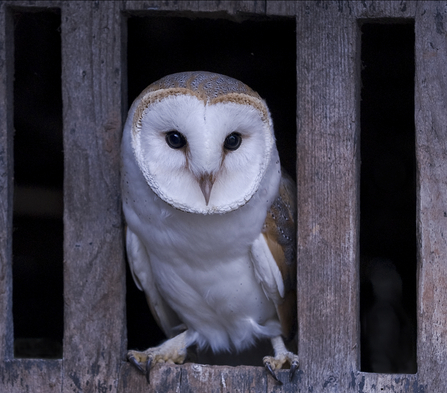
Barn owl by Brian Eacock
Barn owl
Barn owls are pale and slender birds, typically with white on the underparts and golden-brown with grey markings on the upperparts. They have a white, heart-shaped facial disk with dark eyes. This, and their pale plumage, separate them from our other resident owls. They're usually seen over grassland or farmland and winter can be a great time to see them as they often seen at dawn or dusk - just as we're on our way to and from work.
In flight they often give the impression of a large white bird and have earned the name 'ghost owl'. Barn owl calls with eerie squeals and a shrieking 'shreeee'. Take a listen...
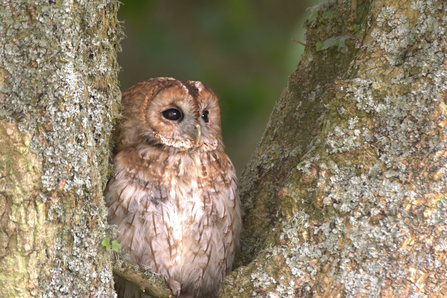
Tawny owl by Jason Curtis
Tawny owl
'Tawnies' are mostly brown, fairly compact owls with a large, rounded head. They're a little larger than barn owls and are usually seen in woodland. The plumage is mottled brown but can vary from greyish to reddish brown - great camouflage against a backdrop of trees. The facial disk of tawny owls is mostly plain,with a narrow, darker wedge extending down between the large black eyes.
In flight, these beautiful birds show broad, rounded wings. Look for a very direct flight with quick wingbeats and long, straight glides; they often only fly short distances from tree to tree. They like to hunt from perches, swooping down to prey on the ground. Tawny owls are largely nocturnal and rarely seen during the day.
Tawny owls have a rich repertoire of calls and are often heard on autumn and winter evenings. Listen for the short 'ke-wik' contact call and the quavering 'hoo, hu-hooo' advertising call.
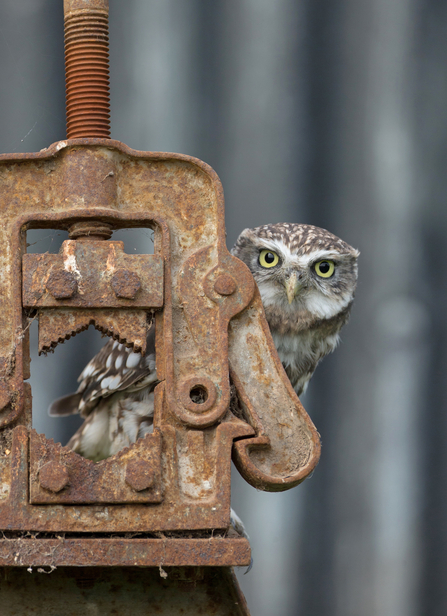
Little owl by Pete Walkden
Little owl
Little owls are small and compact with a rather flattened crown. Their upperparts are dark brown with whitish streaks and spots, which are large on the back but fine on the head. If you catch sight of the back of a little owl, look for larger whitish markings that give the impression of a false face on the back of the head. Their underparts are whitish with bold brown streaks. and their facial disk is greyish brown with prominent whitish ‘eyebrows’ that give them a rather stern expression. Their eyes are yellow.
Little owls fly with a fast, bounding flight though you may see a more direct, flapping flight over short distances. They hunt by swooping down from a perch but they'll also run across the ground in pursuit of prey, which may look a little comedic if you're lucky enough to spot them doing it. They're most active at dawn and dusk but can often be seen during the day.
With a variety of calls, listen for their fast 'chi-chi-chi' alarm call, a low-pitched hoot, and this mewling call...
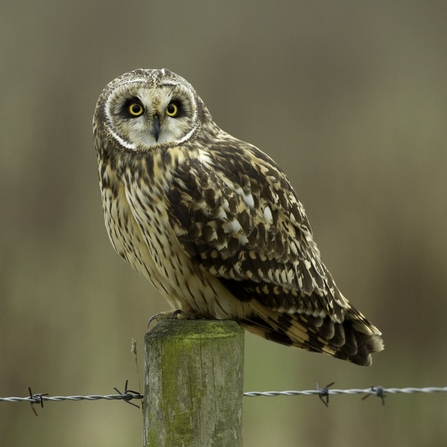
Short-eared owl © Ben Hall/2020VISION
Short-eared owl
These sandy-brown owls are similar in size to tawny owls but have longer wings. The upperparts are mostly yellowish-brown with darker streaks, whilst the underparts are a paler yellow with dark streaks on the breast. The facial disks are a pale whitish or yellowish-brown, with a well-defined border and darker patches surrounding the piercing yellow eyes, as if the owl were wearing a lot of black eyeshadow! Short-eared owls have short ‘ear-tufts’ on top of their head, though they are usually barely visible.
When they're flying, look for the long, narrow wings - compared to long-eared owls, which they're most easily confused with, their wings are slightly longer and more slender, with solid black wingtips (as if they've been dipped in ink). Short-eared owls have a streaked breast but a pale, un-marked, belly and thick dark barring on the tail. You might also be able to see a white trailing edge to the upper wings. Flying with slow wingbeats and wavering glides, they often hunt during the day as well as at night. They breed mainly on moorland but are sometimes seen in winter in Worcestershire when their numbers in the UK are boosted by migrants that arrive from the continent.
You may not hear the call of a short-eared owl in Worcestershire as they are rarely heard away from their breeding grounds, where males sometimes perform display flights, giving a fast series of deep hoots as well as short, quick wing-claps. Other calls are rasping barks, which are given in a quick series when birds are alarmed, like this one...
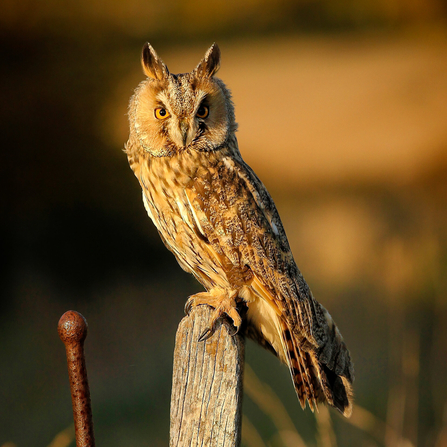
Long-eared owl © Jon Hawkins - Surrey Hills Photography
Long-eared owl
These streaky brown owls look very similar to short-eared owls but they have generally darker feathers and less of a yellow hue. Their facial disks are buff with a well-defined blackish border and white ‘eyebrows’ extending down towards the beak. Their eyes are deep orange and only have a little bit of black feathering around the inner edge (these don’t surround the eye, as in short-eared owls). There are long, obvious ‘ear-tufts’ on the top of the head, though these can be lowered and less conspicuous than you might imagine.
In flight, it can be tricky to separate from long- from short-eared owls. Long-eared owls are slightly shorter and have more blunt-tipped wings with fine black barring on the wingtips (compared with the solid black wingtips of short-eared owls). The dark streaking on the breast extends down over the belly, giving a darker appearance to the underside. The dark barring on the tail is finer than in short-eared owls and there is no white trailing edge to the upper wing.
These are typically nocturnal hunters but you may be lucky enough to see one hunting during the day (adding to the confusion of whether or not it's a short-eared owl). Like short-eared owls, the number of resident birds is boosted in winter as they are joined by migrants from further east. Although long-eared owls are very rare in Worcestershire, elsewhere they can form communal roosts. Whether you're lucky enough to spot multiple birds at a roost or one on its own, they are very sensitive to disturbance so should be viewed from a distance.
Male long-eared owls advertise their presence with deep, soft hoots with no inflection, given in a regular series with a hoot every few seconds, sometimes giving weak wing-claps as they fly over their territory. Females have a more nasal call. Where they breed, the begging call of chicks can be heard from a great distance: high pitched squeaks like the hinges of a rusty gate...

